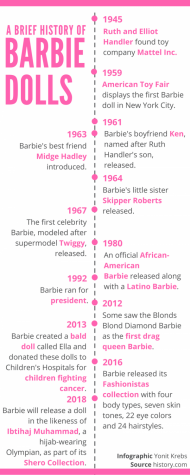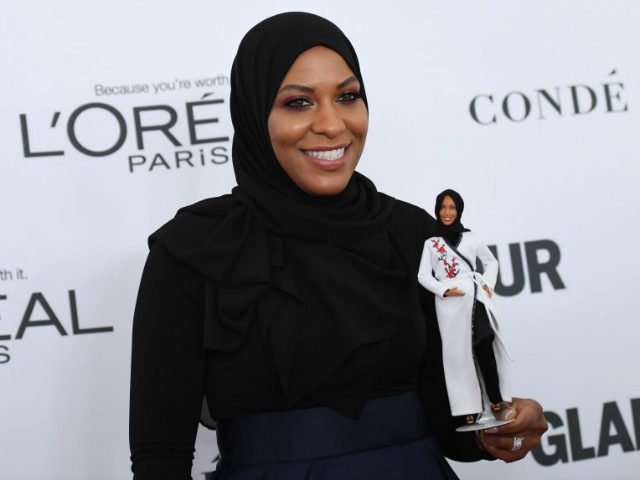Barbie to release hijab-wearing doll in 2018
Doll modeled after Olympic athlete
December 27, 2017
On Nov. 13 at the 2017 Glamour Women of the Year Summit, Mattel launched a new doll in its Shero, female hero, collection. The doll is modeled after Ibtihaj Muhammed, an Olympic medal-winning fencer who was the first American to compete wearing a hijab, according to Mattel.
According to Mattel’s Barbie website, other Shero dolls include Olympic gymnast Gabby Douglas, director Ava Duvernay, and plus-size model Ashley Graham. However, this doll, available in 2018, will fea ture a doll’s with hair completely covered by a hijab, a traditional Muslim head covering.
ture a doll’s with hair completely covered by a hijab, a traditional Muslim head covering.
After hearing about Barbie’s release of a hijab-wearing doll, junior Adna Mohamud said she thinks Barbie’s decision sends a message of inclusion that could spread to other companies and brands.
“I think it is very cool that we are accepting all cultures because there are many types of people in America and it is really cool to have them all represented, even in Barbie form,” Mohamud said. “Once you start a trend, others will follow.”
Mohamud said dolls depicting Muslim figures could also encourage awareness of a minority population.
“(By selling Muslim dolls), America is showing (Muslims) and showing that we exist and acknowledging our presence,” Mohamud said. “Since now you know that they exist, maybe you could get to know a bit more about them and not just the stereotypes you see in the media.”
According to Forbes, Barbie launched its ‘Fashionistas’ doll line in 2016 which features four different body types, original, curvy, petite and tall, available in a variety of skin tones and hairstyles.
Park psychology teacher Gregory Goddard said although it is too soon to know the full affect these newer Barbie dolls will have, previous studies show the toys a child is exposed to, have a significant influence on how they view themselves.
“A husband and wife did a study back in the 1940s regarding racial preference for particular dolls,” Goddard said. “They found that whether you were black or you were white, many of the children chose the white, caucasian doll over the black doll. This may have been in part that not many black dolls were available to black children, but also the children were seeing white as the preferred race.”
Senior Joshua Somaiah said he thinks Barbie including different kinds of dolls will help celebrate different cultures.
“There are actual human beings that look different (and) have different cultures,” Somaiah said. “We have a diverse earth. Why not get the representation of each individual instead of just one group of people thinking they are superior.”
According to American Girl Senior Public Relations Manager Stephanie Spanos, Mattel is the parent company to another well-known doll brand besides Barbie: American Girl. Spanos said diversity and inclusivity are values essential to the core mission of the American Girl collections.
“I would say from the very start we’ve had a diverse selection of dolls especially as we added more products lines,” Spanos said. “So as of today I feel like I can really honestly say, and I’m proud to say, that American girl has one of the most diverse and inclusive set of dolls today.
Spanos said diversity encompasses more than ethnic differences and she said American Girl offers a variety of accessories to achieve inclusivity and representation of all girls.
“That diversity includes and even goes beyond ethnic diversity,” Spanos said. “It is also numerous doll options and accessories that speak to girls in special circumstances. I think it’s important that children see themselves represented in the toys that they’re playing with.”
According to the Washington Times and New York Times, brands like Fulla and Razanne have been creating dolls that wear hijabs and dress according to traditional Muslim modesty guidelines as an alternative to Barbie since the late ‘90s and early 2000s.
Although American Girl does not have any Muslim dolls in their collections, Spanos said it is possible that one could be released in the coming years.
“I think if you look at some of our more recent introductions and just our commitment to diversity and inclusivity, that (including Muslim dolls) would definitely be the goal,” Spanos said. “There’s numerous ways that we really try and represent girls here at American Girl. Sometimes it’s through our products, sometimes it’s through, American Girl Magazine, and we really make attempts to feature stories about girls from all different backgrounds.”
Somaiah said including a diverse collection of dolls will provoke consumers to learn more about other cultures.
“I do believe (the doll will) educate if they do try and learn the reasoning for the hijab or why they (including more diverse dolls),” Somaiah said.
Goddard said he thinks Barbie’s new doll lines will be positive influences on the children who are exposed to them.
“We do know when playing with an image as idealistically slender as the ideal body type, it certainly will affect children’s perceptions of what is ideal,” Goddard said. “It is nice for me to see that Mattel is now realizing that there are a lot of different ways to portray females to children in the form of dolls, whether that’s wearing the hijab or whether that be different ways of having the hair be curled.
Mohamud said including more diverse representation in dolls could improve young girls’ self-confidence.
“Sometimes for me I didn’t really feel pretty because it wasn’t me in those dolls so I think this will help young girls feel pretty,” Mohamud said.





